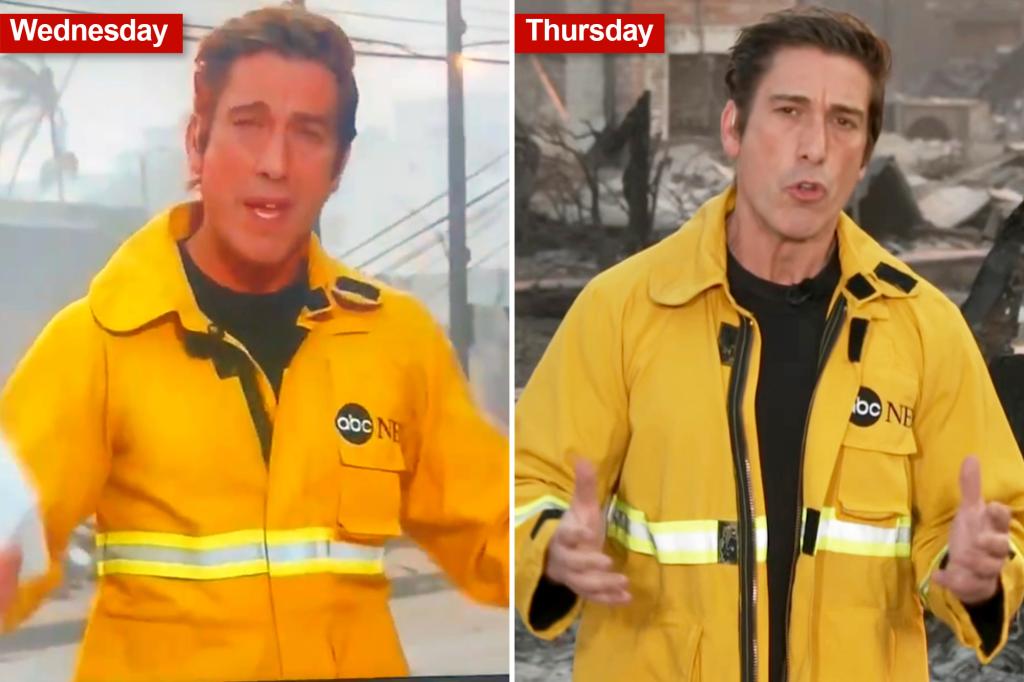David Muir, the anchor of ABC’s “World News Tonight,” found himself embroiled in a sartorial controversy while covering the devastating wildfires in Los Angeles. Initially, Muir’s attire, a bright yellow fire-retardant jacket, seemed appropriate for the setting. However, keen-eyed viewers quickly spotted a waist-cinching clamp affixed to the back of his jacket, a detail that ignited a firestorm of criticism on social media. Many deemed the use of the clamp as vain and narcissistic, particularly in the context of reporting on a natural disaster. The incident sparked accusations of prioritizing appearance over the gravity of the situation, with some commentators sarcastically applauding Muir’s concern for his on-camera physique while homes burned in the background. The backlash prompted Muir to alter his attire during subsequent broadcasts, appearing in a noticeably looser version of the yellow jacket and later ditching it altogether for a more understated black sweatshirt. While Muir remained silent on the controversy, the incident served as a stark reminder of the scrutiny faced by public figures, particularly in the age of social media.
The controversy surrounding Muir’s attire underscored a broader discussion about the role of image and presentation in news broadcasting. Critics argued that Muir’s use of the clamp projected an image of superficiality, undermining the seriousness of the wildfire crisis. The incident highlighted the delicate balance that news anchors must strike between maintaining a professional appearance and avoiding distractions that could detract from the news itself. Muir’s decision to subtly adjust his wardrobe following the initial backlash suggested an awareness of this delicate balance, acknowledging the potential for personal choices to overshadow the importance of the news being reported. Furthermore, the incident underscored the power of social media in shaping public perception and holding public figures accountable for their choices. The swift and widespread condemnation of Muir’s attire demonstrated the potential for social media to amplify criticisms and influence individual behavior.
The criticism levied against Muir wasn’t limited to social media. Prominent media personalities, including Megyn Kelly, also weighed in on the controversy. Kelly, known for her outspoken commentary, lambasted Muir’s actions, characterizing them as a display of “abject vanity.” She further criticized Muir’s presence at the scene of the wildfires, accusing him of “pretending to be a fireman.” Kelly’s remarks added fuel to the fire, amplifying the criticism and further solidifying the negative narrative surrounding Muir’s wardrobe choice. Her comments also highlighted the prevalence of criticism within the media industry itself, where public figures often face scrutiny from their peers.
The incident also reportedly caused ripples within ABC News, with sources claiming that some within the network were “embarrassed and horrified” by Muir’s perceived fashion faux pas. These internal reactions underscored the potential for such incidents to damage the credibility and reputation of not only the individual involved but also the news organization they represent. The reported internal dissent highlighted the pressure faced by news anchors to maintain a professional image that aligns with the values and standards of their news organization. The internal fallout also suggested that Muir’s actions were viewed not merely as a personal lapse in judgment but as a potential reflection on the network as a whole.
The criticisms directed at Muir ranged from accusations of vanity and narcissism to concerns about his journalistic integrity. Some critics questioned whether his focus on appearance overshadowed his commitment to reporting the news accurately and objectively. The incident raised broader questions about the role of personality and image in modern news broadcasting and the potential for such factors to influence public perception of news anchors and the news they deliver. The controversy also underscored the evolving expectations of viewers, who increasingly demand authenticity and transparency from news personalities. The incident highlighted the growing importance of aligning personal presentation with the gravity and seriousness of the news being reported.
The “clothes peg” incident, as it became known, served as a case study in the challenges faced by news anchors in navigating the complexities of public image in the age of social media. The incident underscored the importance of considering context and optics when making wardrobe choices, particularly when reporting on sensitive or tragic events. The swift and intense backlash against Muir demonstrated the potential for seemingly minor details to become amplified and distorted in the online sphere, leading to reputational damage and public scrutiny. The incident served as a reminder that in the 24/7 news cycle, every aspect of a news anchor’s presentation is subject to public scrutiny and can have far-reaching consequences. The incident also served as a teachable moment for aspiring journalists and seasoned professionals alike, highlighting the importance of image management and the potential pitfalls of prioritizing personal appearance over the substance of the news being reported.










